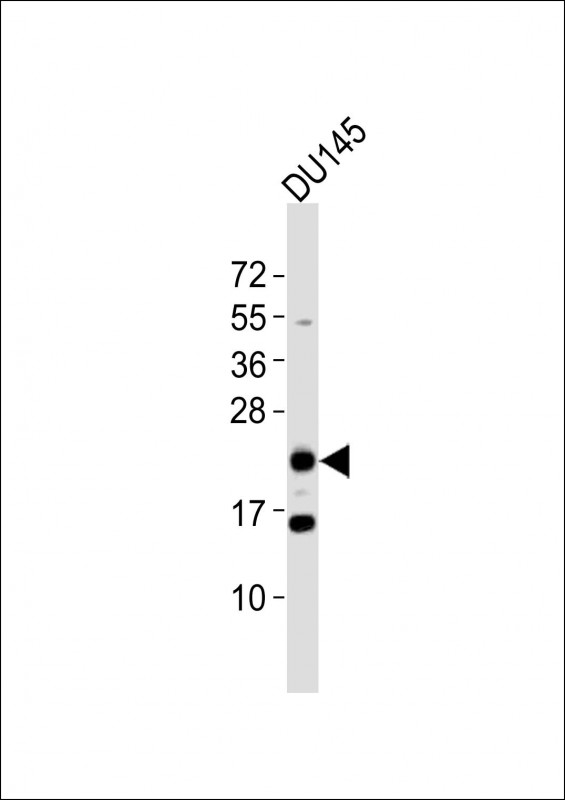BTG4 Antibody (C-term)
Affinity Purified Rabbit Polyclonal Antibody (Pab)
- SPECIFICATION
- CITATIONS
- PROTOCOLS
- BACKGROUND

Application
| WB, E |
|---|---|
| Primary Accession | Q9NY30 |
| Other Accession | NP_060059.1 |
| Reactivity | Human |
| Host | Rabbit |
| Clonality | Polyclonal |
| Isotype | Rabbit IgG |
| Calculated MW | 25970 Da |
| Antigen Region | 142-169 aa |
| Gene ID | 54766 |
|---|---|
| Other Names | Protein BTG4, BTG family member 4, Protein PC3b, BTG4, PC3B |
| Target/Specificity | This BTG4 antibody is generated from rabbits immunized with a KLH conjugated synthetic peptide between 142-169 amino acids from the C-terminal region of human BTG4. |
| Dilution | WB~~1:2000 E~~Use at an assay dependent concentration. |
| Format | Purified polyclonal antibody supplied in PBS with 0.09% (W/V) sodium azide. This antibody is purified through a protein A column, followed by peptide affinity purification. |
| Storage | Maintain refrigerated at 2-8°C for up to 2 weeks. For long term storage store at -20°C in small aliquots to prevent freeze-thaw cycles. |
| Precautions | BTG4 Antibody (C-term) is for research use only and not for use in diagnostic or therapeutic procedures. |
| Name | BTG4 |
|---|---|
| Synonyms | PC3B |
| Function | Adapter protein that bridges CNOT7, a catalytic subunit of the CCR4-NOT complex, to EIF4E (By similarity). Facilitates maternal mRNAs decay during the maturation of oocytes and in the fertilized egg, and is required for the maternal-zygotic transition (MZT), zygotic cleavage and initiation of embryonic development (PubMed:32502391). |
| Tissue Location | Expressed in oocytes after germinal vesicle breakdown (PubMed:32502391). Expressed in testis and in olfactory epithelium. |

Thousands of laboratories across the world have published research that depended on the performance of antibodies from Abcepta to advance their research. Check out links to articles that cite our products in major peer-reviewed journals, organized by research category.
info@abcepta.com, and receive a free "I Love Antibodies" mug.
Provided below are standard protocols that you may find useful for product applications.
Background
The protein encoded by this gene is a member of the BTG/Tob family. This family has structurally related proteins that appear to have antiproliferative properties. This encoded protein can induce G1 arrest in the cell cycle.
References
Xu, Y., et al. Int. J. Cancer (2010) In press :
Dong, W., et al. Biochem. Biophys. Res. Commun. 387(1):132-138(2009)
Toyota, M., et al. Cancer Res. 68(11):4123-4132(2008)
Auer, R.L., et al. Genes Chromosomes Cancer 43(1):1-10(2005)
Yoshida, Y., et al. Jpn. J. Cancer Res. 92(6):592-596(2001)
If you have used an Abcepta product and would like to share how it has performed, please click on the "Submit Review" button and provide the requested information. Our staff will examine and post your review and contact you if needed.
If you have any additional inquiries please email technical services at tech@abcepta.com.













 Foundational characteristics of cancer include proliferation, angiogenesis, migration, evasion of apoptosis, and cellular immortality. Find key markers for these cellular processes and antibodies to detect them.
Foundational characteristics of cancer include proliferation, angiogenesis, migration, evasion of apoptosis, and cellular immortality. Find key markers for these cellular processes and antibodies to detect them. The SUMOplot™ Analysis Program predicts and scores sumoylation sites in your protein. SUMOylation is a post-translational modification involved in various cellular processes, such as nuclear-cytosolic transport, transcriptional regulation, apoptosis, protein stability, response to stress, and progression through the cell cycle.
The SUMOplot™ Analysis Program predicts and scores sumoylation sites in your protein. SUMOylation is a post-translational modification involved in various cellular processes, such as nuclear-cytosolic transport, transcriptional regulation, apoptosis, protein stability, response to stress, and progression through the cell cycle. The Autophagy Receptor Motif Plotter predicts and scores autophagy receptor binding sites in your protein. Identifying proteins connected to this pathway is critical to understanding the role of autophagy in physiological as well as pathological processes such as development, differentiation, neurodegenerative diseases, stress, infection, and cancer.
The Autophagy Receptor Motif Plotter predicts and scores autophagy receptor binding sites in your protein. Identifying proteins connected to this pathway is critical to understanding the role of autophagy in physiological as well as pathological processes such as development, differentiation, neurodegenerative diseases, stress, infection, and cancer.



